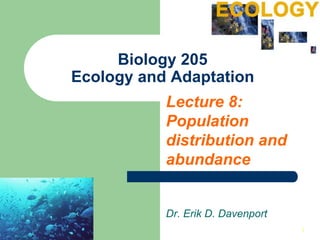
Biology 205 8
- 1. 11 Biology 205 Ecology and Adaptation Lecture 8: Population distribution and abundance Dr. Erik D. Davenport
- 2. 22 Population How do ecologist define population? What are some characteristics of a population?
- 3. 33 Population Ecologists usually define a population as a group of individuals of a single species inhabiting a specific area. – Characterized by the number of individuals and their density. – Additional characteristics of a population include age distributions, growth rates, distribution, and abundance.
- 4. 44 Outline What determines or limits the population distribution? What are the distribution patterns of a population? What is the relationship between Organism Size and Population Density? Commonness and Rarity --- determines whether a population (species) is a common species or a rare species.
- 5. 55 Distribution Limits Physical environment limits geographic distribution of a species. – Organisms can only compensate so much for environmental variation.
- 7. 77 Distributions and Climate: Kangaroo Study Caughley found a close relationship between climate and distribution of the three largest kangaroos in Australia. – Macropus giganteus - Eastern Grey Eastern 1/3 of continent. – Macropus fuliginosus - Western Grey Southern and western regions. – Macropus rufus - Red Arid / semiarid interior.
- 8. 88 Distributions and Climate: Kangaroo study Limited distributions may not be directly determined by climate. – Climate often influences species distributions via: Food production Water supply Habitat Incidence of parasites, pathogens and competitors.
- 9. 99 Tiger Beetle of Cold Climates
- 10. 1010 Tiger Beetle of Cold Climates Tiger Beetle (Cicindela longilabris) lives at higher latitudes and elevations than most other species in NA. – Schultz et. al. found metabolic rates of C. longilabris are higher and preferred temperatures lower than most other species. – Supports generalization that the physical environment limits species distributions.
- 11. 1111 Distributions of Plants along a Moisture-Temperature Gradient Encelia species distributions correspond to variations in temperature and precipitation.
- 12. 1212
- 13. 1313 Distribution of Individuals on Small Scales
- 14. 1414 Distribution of Individuals on Small Scales Random: Equal chance of being anywhere. – Uniform distribution of resources. Regular: Uniformly spaced. – Exclusive use of areas. – Individuals avoid one another. Clumped: Unequal chance of being anywhere. – Mutual attraction between individuals. – Patchy resource distribution.
- 15. 1515 09_11.jpg
- 16. 1616 Distribution of Tropical Bee Colonies Hubbell and Johnson predicted aggressive bee colonies would show regular distributions while non-aggressive species would show random or clumped distributions. – As predicted, four species with regular distributions were highly aggressive. – Fifth was non-aggressive and randomly distributed. – Prospective nest sites marked with pheromones.
- 17. 1717 09_12.jpg
- 18. 1818 09_13.jpg
- 19. 1919 Distributions of Desert Shrubs Phillips and MacMahon proposed as plants grow, some individuals in clumps die, reducing clumping. – Competition among remaining plants produces higher mortality. – Eventually creates regular distributions.
- 20. 2020 Distributions of Desert Shrubs Traditional theory suggests desert shrubs are regularly spaced due to competition of what? – Phillips and MacMahon found distribution of desert shrubs changes from clumped to regular patterns as they grow. – Young shrubs clumped for (3) reasons: Seeds germinate at safe sites Seeds not dispersed from parent areas Asexual reproduction
- 21. 2121 Distributions of Individuals on Large Scales Bird Populations Across North America – Root found at continental scale, bird populations showed clumped distributions in Christmas Bird Counts. – Clumped patterns occur in species with widespread distributions. – Brown found a relatively small proportion of study sites yielded most of records for each bird species in Breeding Bird Survey.
- 22. 2222 09_15.jpg
- 23. 2323 Plant Abundance Along Moisture Gradients
- 24. 2424 Plant Abundance along Moisture Gradients Whittaker examined distributions of woody plants along moisture gradients in several North American mountain ranges. – Documented moisture gradient from moist canyon bottoms up to the dry southwest-facing slopes. – Tree species showed a highly clumped distribution along moisture gradients, with densities decreasing substantially toward the edges of their distribution.
- 25. 2525 Metapopulations A metapopulation is made up of a group of subpopulations living on patches of habitat connected by an exchange of individuals. – Alpine Butterfly - Roland et.al. – Lesser Kestrels - Serrano and Tella.
- 26. 2626 09_22.jpg
- 27. 2727 Organism Size and Population Density
- 28. 2828 Organism Size and Population Density In general, population density declines with increasing organism size. – Damuth found the population density of herbivorous mammals decreased with increased body size. – Peters and Wassenberg found aquatic invertebrates tend to have higher population densities than terrestrial invertebrates of similar size. – Mammals tend to have higher population densities than birds of similar size.
- 29. 2929 Plant Size and Population Density Plant population density decreases with increasing plant size. – Underlying details are very different. – Tree seedlings can live at very high densities, but as the trees grow, density declines progressively until mature trees are at low densities.
- 30. 3030 Commonness and Rarity Rabinowitz devised commonness and rarity classification based on (3) factors: Geographic Range of Species Habitat Tolerance Local Population Size Populations that are least threatened by extinction, have extensive geographic ranges, broad habitat tolerances, and some large local populations. All seven other combinations create some kind of rarity.
- 31. 3131 09_25.jpg
- 32. 3232 Rarity Rarity I – Extensive Range, Broad Habitat Tolerance, Small Local Populations Peregrine Falcon Rarity II – Extensive Rage, Large Populations, Narrow Habitat Tolerance Passenger Pigeon
- 33. 3333 Rarity Rarity III – Restricted Range, Narrow Habitat Tolerance, Small Populations California Condor
- 34. 3434 Main concepts The physical environment limits the geographic distribution of species On small scales, individuals within populations are distributed in patterns that maybe random, regular, or clumped; on larger scales, individuals within a population are clumped. Population density declines with increasing organisms size. Rarity is influenced by geographic range, habitat tolerance, and population size; rare species are vulnerable to extinction.
